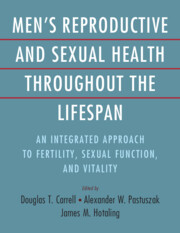 Men's Reproductive and Sexual Health Throughout the Lifespan
Men's Reproductive and Sexual Health Throughout the Lifespan from Section 3 - Clinical Evaluation and Treatment of Male Infertility
Published online by Cambridge University Press: 06 December 2023
The office evaluation of the infertile male involves a comprehensive history and physical structured to uncover all potential causes including congenital, medical, surgical, environmental, genetic, and psychosocial etiologies. The physical exam begins with the patient’s general appearance, body habitus, and progresses to the genital exam in which the testicles are examined for size, consistency, and location. Prior surgical scars, absence of the vas deferens, or the presence of varicoceles may be identifiable causes of infertility. The semen analysis is the cornerstone laboratory evaluation of the male undergoing an infertility workup. The semen is evaluated for several key parameters including volume as well as sperm concentration, number, motility, and form. An endocrine evaluation is indicated in men with oligospermia, azoospermia, or a history of physical examination findings suggestive of hormonal abnormalities including sexual dysfunction, decreased libido, or physical evidence of impair androgenization. Pending the initial workup genetic testing may be indicated.
To save this book to your Kindle, first ensure [email protected] is added to your Approved Personal Document E-mail List under your Personal Document Settings on the Manage Your Content and Devices page of your Amazon account. Then enter the ‘name’ part of your Kindle email address below. Find out more about saving to your Kindle.
Note you can select to save to either the @free.kindle.com or @kindle.com variations. ‘@free.kindle.com’ emails are free but can only be saved to your device when it is connected to wi-fi. ‘@kindle.com’ emails can be delivered even when you are not connected to wi-fi, but note that service fees apply.
Find out more about the Kindle Personal Document Service.
To save content items to your account, please confirm that you agree to abide by our usage policies. If this is the first time you use this feature, you will be asked to authorise Cambridge Core to connect with your account. Find out more about saving content to Dropbox.
To save content items to your account, please confirm that you agree to abide by our usage policies. If this is the first time you use this feature, you will be asked to authorise Cambridge Core to connect with your account. Find out more about saving content to Google Drive.